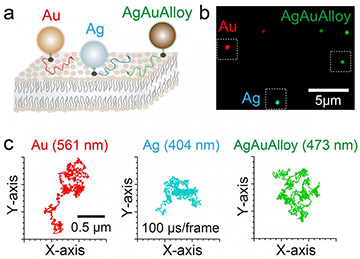By using three different kinds of nanoparticles, rather than the usual one, researchers at Japan’s National Institutes of Natural Sciences have reportedly created a method for fast multicolor imaging of biomolecules. [Image: Ryota Iino, Institute for Molecular Science, National Institutes of Natural Sciences, Japan] [Enlarge image]
To understand how biological cells operate, life scientists track the biomolecules that make up the cells. The most effective means of doing so involves tagging the molecules with gold nanoparticles and tracking laser light that the nanoparticles scatter.
A group at Japan’s National Institutes of Natural Sciences (NINS) has now expanded that approach, allowing scientists to track individual and multiple biomolecules more precisely (ACS Photon., doi: 10.1021/acsphotonics.9b00953). “Our method,” the group writes, “will pave the way to investigate the operation mechanisms of complex biomolecular systems.”
Overcoming the single-color quandary
“Nanoparticles have significant advantages over commonly used organic fluorescent dyes and semiconductor quantum dots because they show much stronger and more stable signals,” explains Ryota Iino, who led the NINS team. But the routinely used plasmonic gold nanoparticles that couple with laser light have one disadvantage: Stimulated by laser light at a wavelength of 561 nanometers, they provide images only in the color green, at 530 nm.
To expand the color palette, Iino’s team used three types of nanoparticle, three different lasers, and a method of combining the images they produced. The team added silver and silver-gold alloy nanoparticles to the conventional gold nanoparticle tags. Researchers had generally ignored those two types of nanoparticle, because their surfaces are easily oxidized, causing fluctuations in the signals they scatter. “But we showed for the first time that surface modification successfully improves the situation,” Iino says.
Opening up the palette
Laser light at 404 nm and 473 nm stimulated the two new types of tag, adding colors at 410 nm and 460 nm, respectively, to the gold-produced 530-nm green. Then, Iino says, “we successfully applied a wide-split spectrometer to easily obtain three-color images completely simultaneously.” The team also used a 649-nm laser to detect coupling between two closely located nanoparticles, an effect that would shift the peak wavelength of the resonance toward the red region.
Iino’s team plans to broaden the color palette beyond the current violet-to-green range. Using nanoparticles with shapes different from the usual spherical type, he says, should produce wavelength coverage closer to red.

